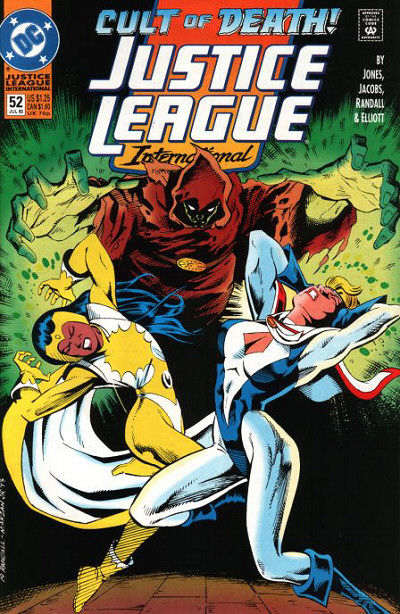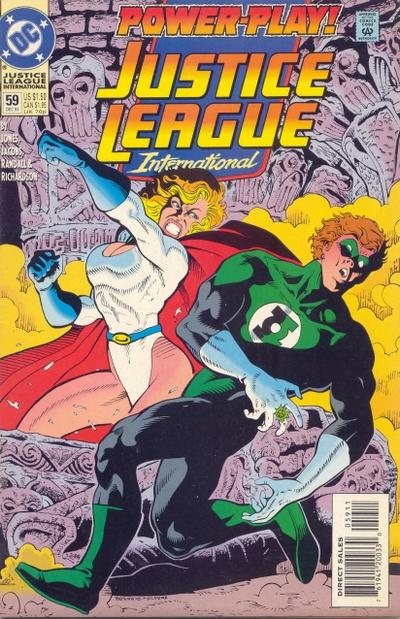It feels like a cliche to say, man, superhero comics used to be so much weirder. It feels like the sort of thing that grumpy old men say because they can’t wrap their heads around Squirrel Girl, and Civil War II isn’t doing it for them like the first one anymore, and who wants to be that guy?
Nonetheless, the primary takeaway I had after reading Justice League International #52-60 the other day — a decision brought on by nostalgia for the early ’90s and for Gerard Jones’ writing — was “well, that was strange.”
 This JLI is, I guess, the second comic to bear that title, and also a forgotten series in a lot of ways…? It’s not the Giffen/DeMatteis book that everyone thinks of when the title is mentioned, nor is it the New 52 book of the same name. Instead, it’s the last couple of years of the book that launched as Justice League Europe; once the Giffen-plotted era came to an end, Gerard Jones, then a rising star at DC thanks to his Green Lantern work, took over as full writer with a young Ron Randall as artist. The book went through… a year or so, maybe more(?) as Justice League Europe under this creative team, then got renamed Justice League International with its 51st issue, which also saw Jones’ The Trouble with Girls co-writer Will Jacobs step on as co-writer. And then, things got weird.
This JLI is, I guess, the second comic to bear that title, and also a forgotten series in a lot of ways…? It’s not the Giffen/DeMatteis book that everyone thinks of when the title is mentioned, nor is it the New 52 book of the same name. Instead, it’s the last couple of years of the book that launched as Justice League Europe; once the Giffen-plotted era came to an end, Gerard Jones, then a rising star at DC thanks to his Green Lantern work, took over as full writer with a young Ron Randall as artist. The book went through… a year or so, maybe more(?) as Justice League Europe under this creative team, then got renamed Justice League International with its 51st issue, which also saw Jones’ The Trouble with Girls co-writer Will Jacobs step on as co-writer. And then, things got weird.
How weird? Well, here are the plots of these nine issues:
- Maya, the team’s newest member, is revealed to be the literal reincarnation of the Hindu goddess of the same name.
- Crimson Fox — remember her? — discovers that her husband is still alive, had faked his death because he was an internationally-wanted cat burglar, but now wants her back even though she’s a superhero. Metamorpho, her then-lover, isn’t convinced by what’s going on, but when he follows her to find out what her decision is, she and her husband are killed in an explosion.
- All of the team start acting wildly out of character — including Dr. Light and Power Girl becoming overcome by lust, because of course — because, get this, they’ve all been replaced by robot duplicates of themselves with their own minds in them, except when they’re being remote controlled by an alien entity from the future who wants them to fight in a war between robots and humanity in the far future. They go, they fight, and then they get their bodies back and run away without actually making any difference in the ongoing war whatsoever.
- The team is defeated by a cult, and then saved by two supporting cast members: an omnipotent silent being who obeys the commands of the team, and a ghost who possessed a suit of armor. Elongated Man chooses the end of this adventure to leave the team, for no seeming reason beyond “Hey, I just realized being in a superhero team is dangerous!”
- A catch-up issue wherein it’s established that the ghost who possesses the suit of armor is in love with Dr. Light and the omnipotent silent being might be an alien child.
- The team is stuck in an alternate reality caused by the humans from the future war the team failed to stop going back in time and undoing the origins of each of the team, and Guy Gardner is Green Lantern, but he’s a really cool Green Lantern, and he ends up being the hero who restores the timeline even though it means he’ll become a jerk with a bad haircut. And at the end of the issue, Crimson Fox returns! Or does she?
And in the middle of this, there are subplots, because it’s a superhero team comic in the 1990s: Is Shiva growing up too fast? Who is the father of Power Girl’s baby, because she can’t remember! Is Metamorpho heartbroken about the death of his lover, and if so, is the fact that that really doesn’t seem to the case a plot point or just bad writing?
 Everything in the book unfolds in this strange, tumbling narrative that isn’t necessarily fast, but feels out of control nonetheless. So much of the book seems to be nonsensical and haphazard — literally, the plot about the future war just disappears almost without a trace for three issues, and is then the primary motivator for the next two without warning — that it feels thrilling and terrifying at the same time; everything has the sense of being created at the last moment and by people who don’t have time to double check what the fuck was going on last month, dammit. It’s superhero comics as fever dream.
Everything in the book unfolds in this strange, tumbling narrative that isn’t necessarily fast, but feels out of control nonetheless. So much of the book seems to be nonsensical and haphazard — literally, the plot about the future war just disappears almost without a trace for three issues, and is then the primary motivator for the next two without warning — that it feels thrilling and terrifying at the same time; everything has the sense of being created at the last moment and by people who don’t have time to double check what the fuck was going on last month, dammit. It’s superhero comics as fever dream.
And all of this is illustrated by Ron Randall, whose work at the time was rarely overly dynamic, an impression only made worse by the fact that the inkers he has during this run are weirdly, mechanically precise and unbothered by the concept of differentiating line weight or emphasizing elements of the pencils for impact. There are moments that work well — and his women are consistently pretty, with that coming across as a particular point of pride for the artists, unusually for superhero comics, especially of the 1990s — but on a whole, it just adds to the idea that JLI was a series that wasn’t just not the sum of its parts, but a series where the various parts weren’t really adding up as such as pulling in different directions with none necessarily sure where they wanted to go in the first place.
(Randall has, of course, done a bunch of work that’s far more worth your time and attention; his Trekker — created both before and after these JLI issues — are probably my favorite of his stuff, and far more in tune with his sensibilities.)
These are, no doubt, “weird” superhero comics, and far more weird than anything on the shelves today. But I’m not entirely sure that they were intended to feel this weird; I suspect that a lot of the oddness comes from an indecisiveness about what the series was supposed to be, and where it was supposed to be going in the long run. Maybe the reason for the strangeness is the same as the reason for so much of my beloved 1970s and ’80s strangeness: confusion and mistakes and deadlines and the inability to go back for a redo because time was a-pressin’.
We don’t get that, now; comics are delayed, comics miss ship dates, and there isn’t really the same… I don’t know, pulpy abandon because of everything to do with Comics 2016: the self-consciousness of the creators, the over-analyzing of the audience, the price point that would understandably have had readers looking at one of these JLI issues and saying, “this really isn’t worth $2.99,” never mind Marvel’s favored $3.99 or $4.99 prices. Something has been lost, sure, in getting to this point, but there are so many reasons, I’m not sure if or how it could ever come back at this point — or even if we should really want those days back.


It wasn’t a great period, though I did like Maya – she had a great visual and it was a change to have a hero from an Indian tradition (this argument does not apply to Rama in Wonder Woman, who was just pants).
It’s hard to think of Ron Randall as being young back then given he’d been a comics professional for a decade, drawing the likes of Arak, but from a 2016 perspective, mebbes!
‘People who don’t have the time to doublecheck’ is my feeling about Jones and Jacobs after reading their book ‘The Great Comic Book Heroes’. I was enjoying their breezy style and thought I was learning some interesting stuff, until I reached these lines on the Black Racer ‘(Kirby) made him an injured man transfigured by Darkseid rather than a creature of pure energy as his Surfer had been.’ As for wacky shortly after that odd bit of mis-remembering, they declare Orion is in some way analogous to FDR. Maybe that means more to US-ers, but I couldn’t see it myself.
I know they’ve written a well received history of comic book creators, but my doubts about their interest in accuracy has kept me away.